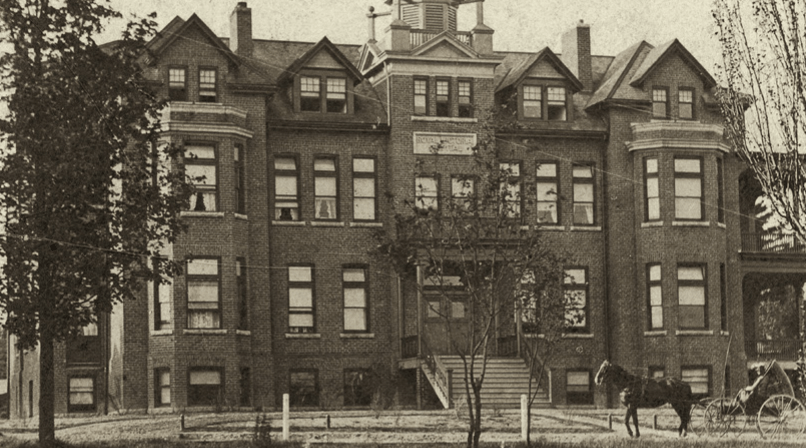Over 125 years of caring for our community
2022 marked the 125th year RVH has been providing care to the community, 25 years since the opening of our current site and the 10th anniversary of the official opening of the Phase 1 Expansion.
RVH’s roots actually go back to 1891 when a group of women banded together to fund a four-bed hospital – the Barrie General Hospital on Duckworth Street. But, as the population of Barrie started to grow, four beds was not enough to keep up with healthcare demand and a larger hospital, with room for 13 patients, was built on High Street.
In recognition of Queen Victoria’s Jubilee, it was renamed Royal Victoria Hospital and opened on June 22, 1897. In 1902, a new 35-bed hospital, at a cost of $20,000, was built on Ross Street. Over the years the Ross Street site expanded but the need to grow continued. In 1995, construction began on our Georgian Drive site which opened in 1997.
Very quickly, RVH needed more space on Georgian Drive and in 2005 got approval for the Phase 1 Expansion and broke ground in 2009.
Today, RVH is a regional health centre with many specialized programs and a highly skilled and dedicated team. And RVH is not done growing yet – having submitted a Stage 1 plan to the province for the expansion and redevelopment of Georgian Drive – the North Campus, as well as a new South Campus in Innisfil.
RVH has come a long way since 1897, but one thing has never changed – providing safe high-quality care for residents of the region. RVH is always here for you.
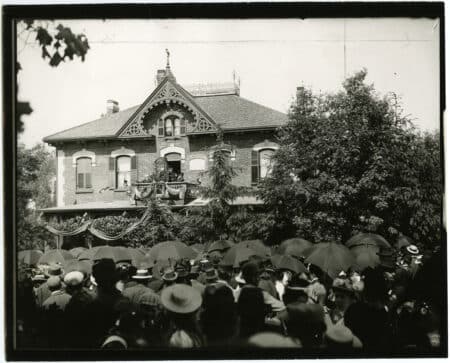 “Rooms are bright, cheery, well-ventilated and lit by electricity.”
“Rooms are bright, cheery, well-ventilated and lit by electricity.”
So reported the local newspaper when the new 13-bed Royal Victoria Hospital (RVH) opened 125 years ago on June 22, 1897.
This “modern” facility on High Street replaced Barrie General Hospital, a four-bedroom cottage on Duckworth Street built in 1891 with $1,100 in funds raised by four local women. Opening on the same day as Queen Victoria’s Diamond Jubilee, the hospital was renamed Royal Victoria Hospital (RVH) in the sovereign’s honour.
Barrie’s population continued to grow, surpassing 8,000 by the early 1900s. By 1903 RVH had moved to a new location with 35 beds on Ross Street, across from Queen’s Park, fully constructed and furnished for $20,000.
The Ross Street site grew to 315 beds by the late 1960s. In 1985, a new 16-bed Critical Care Unit was also added, but it still wasn’t enough to meet the steady population demands of the region, and the increasing need for more modern and high-tech healthcare. A new hospital on a new site was the answer.
In 1997, the next iteration of RVH was opened on Georgian Drive at a total cost of $125 million. But growth was inevitable, and a massive expansion began on the site in 2005. With a price tag of $450 million, the expansion included the building of the Simcoe Muskoka Regional Cancer Centre.
RVH continued to add services and by 2012, its name was changed to Royal Victoria Regional Health Centre (RVH) to better reflect its significance as a hub for advanced care in the region.
As has been the case since 1897, once RVH completes an expansion, continuous regional population growth means it’s time to plan another.
RVH’s next chapter involves doubling the size of the Georgian Drive location (North Campus) within the decade to include a nine-storey inpatient unit. At the same time, RVH will build a second location in Innisfil (South Campus) — a Health Hub focusing on outpatient care, including an Urgent Care Centre. Within 20 years, the South Campus is expected to be a full-service hospital with a 24/7 Emergency Department seeing 350,000 patients each year.
Electricity may no longer a key selling point, but the need grows in pace with the community and the desire to provide the most exceptional and advanced care to patients remain the same as they did 125 years ago.
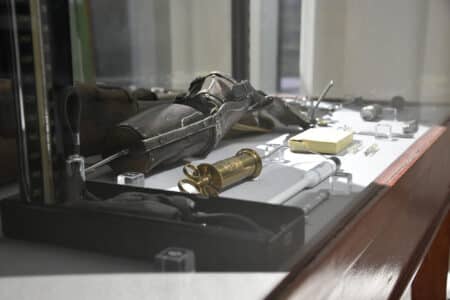
In 1903, when Royal Victoria Hospital (RVH) moved into its newly built home on Ross Street, local media reported that Barrie now had “one of the prettiest and most up-to-date hospitals in Canada.”
“A very interesting feature of the opening ceremonies,” the paper went on to say, “was the exhibition and demonstration of the X-ray machine.”
The discovery of X-ray technology in 1895 had marked the beginning of a new medical discipline called radiology. For the first time, physicians could look inside the human body without cutting it open, and RVH brought this new technology to the people of Barrie.
Over a century later, radiology has become an essential tool in diagnosing and treating disease and RVH, now Royal Victoria Regional Health Centre, continues to lead the way in acquiring advanced imaging technology and equipment.
Next summer, RVH will add one of the most powerful and advanced tools for early and more accurate cancer detection to its diagnostic arsenal — a PET-CT scanner.
A PET-CT scan is painless and non-invasive procedure lets doctors see what happening with the body at a molecular level.
The PET part which stands for Positron Emission Tomography involves first injecting a patient with a very small and safe amount of a radioactive drug. Diseased cells in the body absorb more of the radiation than healthy ones do, so, during the scan itself, the machine detects the radiation in the damaged cells and produces images of the affected tissue.
The CT, or Computed Tomography part of the machine, takes a series of X-rays all around the body and puts them together make a 3D image. The PET-CT combines the images, giving doctors a clearer picture of what’s going on.
Dr. Drew Schemmer, RVH Chief of Medical Imaging, explains “The scan helps radiologists see exactly where cancer is located. It helps us find certain diseases earlier when they may be more treatable, gives us information to devise the best treatment plan possible, and it can show us how well a patient’s treatment is working.”
For 125 years, RVH has been committed to providing exceptional care for patients. From an X-ray machine to a PET-CT scanner to whatever mind-blowing technology comes next, RVH has always been, and will always be, focused on bringing world-class care closer to home.
In 1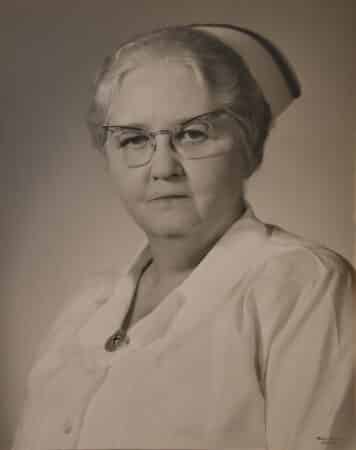 925, Barrie’s Royal Victoria Hospital (RVH) was state-of-the-art. It had an appointed medical staff, a bed capacity of 35, operating rooms and an x-ray machine.
925, Barrie’s Royal Victoria Hospital (RVH) was state-of-the-art. It had an appointed medical staff, a bed capacity of 35, operating rooms and an x-ray machine.
It also had Miss Helen J. Shanahan.
As a young student accepted to the Royal Victoria Hospital School of Nursing in December 1921, Miss Shanahan was full of confidence and ambition. Just one year after graduation, she earned the position of Assistant Superintendent at RVH and began her long and storied career.
By 1928, she became qualified as an x-ray technician. Later, during the Second World War, she was the only trained x-ray technician on staff, treating as many as 500 soldiers.
Miss Shanahan supervised the operating room, delivery room and emergency, as well as taking on some teaching roles. She carried out her responsibilities with a strong sense of dedication and leadership and was appointed Superintendent in 1947. In 1958, her title was changed to Administrator and she held this position until her retirement in 1965.
Miss Shanahan lived in residence with the nursing students, keeping a watchful eye over their activities. During her administration years, approximately five hundred nurses graduated from the nursing school and she took great pride in “her girls”.
She was kind and caring, but Miss Shanahan also ran a tight ship. She would often bounce a nickel off hospital beds to see if the sheets were tucked tightly enough and routinely checked the wheels on all the stretchers to ensure they were pointed in the same direction.
As House Mother, Miss Shanahan felt a responsibility for her students’ morals. She was known to pull nurses out of parked cars if they had stayed too long inside with a member of the opposite sex. She installed a bright flood light, fondly known as “Shannie’s Moon”, above the door to Laidlaw Residence to deter the young ladies from lingering with their beaus.
Miss Shanahan provided a strong foundation for both her charges and her successors. Her dedication and sincerity were acknowledged in 1977 when RVH’s “Helen J. Shanahan Ward” was officially opened, and again in 1980 when the alumnae raised $5,000 to set up the Helen J. Shanahan memorial fund.
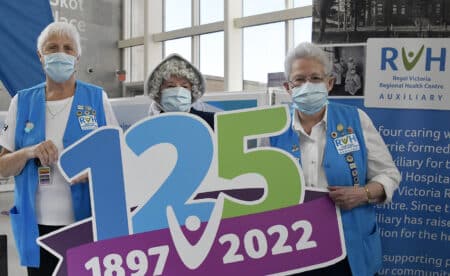
You can’t tell the story of Royal Victoria Regional Health Centre (RVH) without the RVH Auxiliary.
In 1897, Barrie’s new 13-bed hospital, named Royal Victoria Hospital in honour of the Queen’s Diamond Jubilee, opened on June 22. Recognizing the need to outfit the new facility with things like linens, equipment and patient supplies, several women got together to raise the necessary funds. They formalized their group as the Women’s Auxiliary of Royal Victoria Hospital and later, as men joined their ranks, simply the RVH Auxiliary.
The RVH Auxiliary was created for one driving purpose – to support patient care at RVH. And they have worked tirelessly to fulfill that mandate, sewing linens and quilts and knitting baby clothes, dropping by patient rooms with library or snack carts, greeting and portering patients, and raising a staggering amount of money – over $15 million and counting.
From amateur plays held in Barrie’s Grand Opera House, charity balls, lawn socials and pantechnicons (a fancy name for rummage sales held in the evening that featured entertainment); to fashion shows, cookbook sales, cooking classes, bake sales, hospital tours, home tours, bridge groups, bazaars and quilt raffles; to gift shop and café sales; to a Lotto booth and Community 50/50 draws, the RVH Auxiliary has held every kind of fundraising event.
Auxiliary ledgers give a fascinating account of what their funds have purchased over the years. In 1898, they spent $31 on door screens; in 1907 they contributed $1,500 to reduce the hospital mortgage; in 1969, $11,000 went towards equipment for the Urology department; in 1992, $1 million was put towards the Georgian Drive location; in 2006, $5 million was given to the Simcoe Muskoka Regional Cancer Centre.
Despite the setback caused by the COVID pandemic, which has kept Auxiliary members out of the health centre since 2020 (good news: they are scheduled to return to service this fall) and put an end to all in-person fundraising, the Auxiliary is still on track to meet its current pledge of $5 million towards RVH’s next expansion.
Since RVH’s beginnings, the volunteers of the RVH Auxiliary have been dedicated to supporting patient care and enhancing the patient experience. What an extraordinary gift for RVH and our entire community.
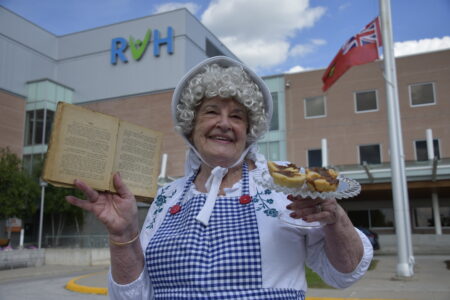 The uniquely Canadian treat known as the butter tart has a long history in this country. Many food historians believe its earliest incarnation was the tooth pain-inducing “sugar pie”, made from maple sugar and maple syrup in every Quebecois kitchen in the late 18th century.
The uniquely Canadian treat known as the butter tart has a long history in this country. Many food historians believe its earliest incarnation was the tooth pain-inducing “sugar pie”, made from maple sugar and maple syrup in every Quebecois kitchen in the late 18th century.
But the first written recipe for butter tarts actually came from Barrie and has close ties to Royal Victoria Regional Health Centre.
According to many sources across the country, including a 2008 article in Toronto Life magazine, “the first known recipe for butter tart filling – the voluptuous mix of eggs, butter, sugar and currents – appeared in a cookbook produced by the Royal Victoria Hospital’s Woman’s Auxiliary in Barrie in 1900, attributed to one Mrs. Malcolm (Mary) MacLeod.” The recipe quickly gained popularity and was reprinted in the Toronto Daily News in 1908.
Simply titled, Filling for Tarts, Mrs. Malcolm MacLeod contributed an unassuming recipe to the Women’s Auxiliary of Royal Victoria Hospital’s 1900 fundraising cookbook. It appeared on page 88 in the “Pies” section directly under Miss McCarthy’s recipe for Plain Pie Crust.
Mrs. MacLeod included succinct details alongside her short list of ingredients: One cup sugar, ½ cup butter, 2 eggs, 1 cup currants; mix. Fill the tarts and bake.
The Royal Victoria Cook Book, containing recipes donated by women from the community, was part of a full fundraising campaign created by members of the Women’s Auxiliary to support Royal Victoria Hospital which had opened 1897.
The cookbook’s preface explained that the Auxiliary was dedicated to raising money to purchase “the many comforts necessary to aid the sick and suffering while they are patients in our Hospital”.
Who would have known Mrs. MacLeod’s modest culinary contribution would go on to become a southern Ontario staple and make history as the earliest-known published butter tart recipe?
This year, in honour of both the RVH Auxiliary and Royal Victoria Regional Health Centre’s 125th anniversary, a limited-edition commemorative butter-tart flavoured coffee and a butter-tart scented candle were curated as a nod to our history and to continue the Auxiliary’s mission to raise funds for patient care.
Both the coffee and candles, along with other 125th anniversary merchandise, can be purchased online at VictoriasGiftShopRVH.com. Curbside pickup or shipping options are available.
1891
The Barrie General Hospital, a tiny cottage with just four beds, was opened on Duckworth Street near Ardagh’s Grove.
1897
A larger hospital (with room for 13 patients) was built on High Street. In recognition of Queen Victoria’s Jubilee, it was renamed Royal Victoria Hospital.
1898
Monthly salaries total $37.87. Patients were charged $1.14 per day for care. (Today the average daily cost for care is almost $500)
1902
A new 35-bed hospital, at a cost of $20,000, was built on Ross Street.
1903
The first X-ray machine, with a water driven motor, was purchased by several members of the medical staff.
1952
After World War II, the population of Barrie soared, so the Memorial Wing was built with 70 beds. By the late 60s RVH had expanded to 315 beds.
1985
A 16-bed Critical Care Unit was added.
1995
Construction started on the new Georgian Drive location.
1997
The new Royal Victoria Hospital opens, on-schedule and under budget.
2005
RVH gets the Green light for the Phase 1 Expansion Project including the Simcoe Muskoka Regional Cancer Centre which will double the size of the current hospital.
2009
RVH breaks ground on the Phase 1 Expansion Project.
2010
RVH breaks ground on Rotary Place which is home to Rotary House, the lodge for cancer patients
2012
RVH introduces a new visual identity and name, becoming the Royal Victoria Regional Health Centre, although it will also continue to be referred to by the well-known acronym “RVH”.
RVH opens its Phase 1 Expansion Project on May 17, 2012.
2013
RVH launches new strategic plan June 17, 2013. MY CARE puts patients and families at the centre of everything we do. Follow the link to the right to review the plan. The plan was refreshed in 2016 and 2018.
2015
RVH gets the ‘green light’ from the provincial government to build an Advanced Cardiac Centre.
2016
RVH gets approval to develop a Child and Youth Mental Health Program including an inpatient unit and Day Program.
2017
To address surging patient volumes, RVH opens a 40-bed Transitional Care Unit.
The health centre celebrates the opening of the Simcoe Muskoka Regional Child and Youth Mental Health Inpatient Unit in December.
2018
The Simcoe Muskoka Regional Heart Program opens in January featuring a state-of-the-art Cardiac Intervention Unit. The health centre performs its first angiograms.
RVH embarks on planning for the future of healthcare with its Plan our Future campaign to determine best use of remaining space at the Georgian Drive campus and to begin plans to build a south campus to meet the healthcare needs of residents in south Barrie/Innisfil.
Child & Youth Mental Health Day Program opens in September. In partnership with the Simcoe County District School Board the Day Program provides academic and mental health services for high school students unable to attend regular classes.
Scheduled angioplasties begin in the Cardiac Intervention Unit.
2020-2021
COVID-19 Pandemic
With an unwavering focus on safety, RVH introduced hundreds of new practices and protocols, put screeners at every door, restricted visitors, delayed scheduled surgeries to maintain bed capacity and, essentially, went into lock-down.
We faced a global PPE shortage, opened additional beds, built a field hospital, and supported our long-term care partners as the virus ravaged their homes.
To keep our patients and communities safe during the pandemic, RVH:
- Established an Emergency Command Centre to manage RVH’s response.
- Hired more than 300 additional staff, including screeners, immunizers, nurses, PSWs, cleaners and infection control specialists.
- Renovated spaces and added 100 new beds, including a Regional Pandemic Response Unit.
- Opened screening clinics in Barrie and Innisfil.
- Opened the region’s first Immunization Clinic.
- Accepted the transfer of 90+ patients from over-burdened GTA hospitals.
- Supported 25 Simcoe Muskoka long-term care and retirement homes.
- Expanded our laboratory capabilities to provide in-house COVID testing.
- Introduced virtual visitation and pet therapy while our ‘Blue Brigade’ volunteers are temporarily suspended.

